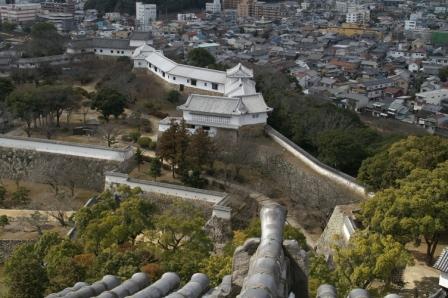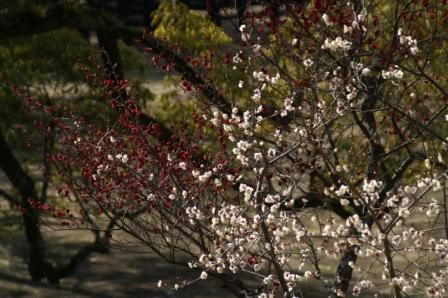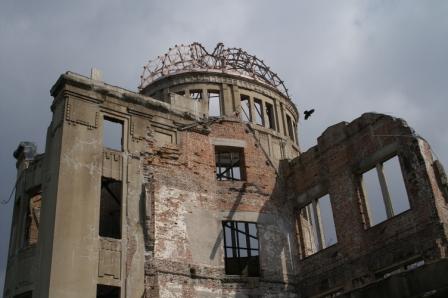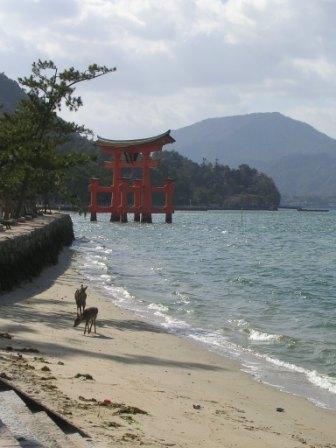Hiroshima, Japan
Sightseeing
Monday, February 25, 2008
 The view from Himeji Castle we visited yesterday.
The view from Himeji Castle we visited yesterday.
Today we are bound for Hiroshima. Julia and I were able
to find some English DVDs last night, so after dinner we watched *Sabrina*,
the one with Humphrey Bogart and Audrey Hepburn. It was such a treat to
watch a movie, as we really have not seen much TV, movies, or video since
December; but strangely, we have not missed them much. Julia had not seen the
movie before, so it really entertained her. In the morning, we ate our
regular breakfast, checked out of the hotel, went over to the Internet
place, and then ate another terrific lunch in our unnamed favorite
restaurant. We do not know its name, as it is in Kanji with no English
translation, but we love eating there because it has the best Japanese food we have had our
entire stay. We dropped into the Post Office and then took our place on the
clockwork train system. One quick stop in Osaka and then direct to
Hiroshima.
 But we love Japan. An early blossom.
But we love Japan. An early blossom.
We considered why the Japanese have the best train system
in the world, or at least the best we have experienced. England invented train
travel, but their current system is merely adequate and nowhere near the
Japanese system. America has no rail system at all in comparison. I remember
when I was a kid in the 60s, there was a vision of the future that looked
very much like what the Japanese have achieved now; what happened to
America, Australia, and England? In fact, in general, the Japanese have a very
low carbon footprint compared to the rest of us, yet they live in very
modern cities and live a very modern life. Certainly, consumerism is not to
blame for the gap between us and them, as I have never seen such consumers
as the Japanese. We read an article in the current issue of *The Economist*
which mentioned how Japanese companies are focused on their workers' welfare
much more than other countries, and this has had a negative impact on their
profitability. Given this, perhaps it is capitalism and the "anything for
profit" attitude that has denied us our dreams. I am sure there are many
counter-arguments to mine, but we sure did something wrong.
On the other hand, Julia and I are reading Bill Bryson's
book *A Short History of Nearly Everything*, and in it, he points to
how devastated the world fishing industry is by overfishing. Given the Japanese
consumption of everything fish, they perhaps have a lot to account for with
this sin.
From Julia: All Japanese cities I have been to so far
look the same to me. Maybe it's just looking at them from trains. They look
very modern, metallic, industrial, and newly constructed. And I have the
impression that if you have to live and work in them, life would be quite
dreary. Although I have no idea of the reality, as being a tourist is
completely different from living in a place. For sure, commuting to work on a
train that zooms along can't be bad. I wished I could've taken a Shinkansen
to Sacramento or LA when I used to go regularly for work. As I sit here,
munching a delicious crunchy thing wrapped in seaweed, it's easy to notice
the nice bits on the train. They are very clean; we saw a cleaning crew go
to work at one station, and they were good! The loos are clean, and Davido San
even encountered a bottom-washing heated seat version on one train. There is
lots of space, like being on a business-class airplane ride, and even
smartly dressed women train attendants. The only downside has been when
smoke from smoking cars has traveled through the air to make our area
smelly and noxious too. In fact, they are far behind Australia, America, and
England with smoking bans.
Wednesday, February 27, 2008
 The A-Bomb building.
The A-Bomb building.
There is destruction in all human nature; this has never
been more evident to me than today, while and after visiting the Hiroshima
A-Bomb memorials. When we arrived at the last remaining building standing
today, which was at the epicenter of the blast, we were fortunate to meet a
Japanese guide who was also a blast survivor. Mito
Kosei is five foot and a few inches tall, with brown eyes and a leathery
complexion. He is in fact 65 years young and was very friendly and
enthusiastic with us.
 Julia at the Peace Bell.
Julia at the Peace Bell.
He proudly told us that he was in his mother's womb the
day of the blast and that his mother was fortunately far enough away to have
survived instantaneous vaporization, which was the fate of thousands of
souls that day. She did eventually develop blood cancer but is still with
him today; 90 years young. He would not go into detail, but he has had
various illnesses all of his life. His father, while teaching school, was
much closer to the blast but was fortunate to be in a basement at the time
of the detonation. He also developed radiation-related illnesses and died in
his old age from them. His uncle, who also survived the initial blast, died
shortly after from radiation sickness. Mito guided us to various sites not
in our tour book and has done this with 8,000 people over the years,
explaining that it is his life's passion to ensure that all he meets
understand the consequences of using nuclear weapons. It was hard for
me to contain the sadness I felt as he told the stories of the river, which
runs through the site, full of dead bodies, and of cremation funeral pyres that
burnt for days after the explosion. As he showed us photographs of burn
victims, we were glad to have met him but also distressed to have the
reality of this horrific event given to us firsthand. He
wanted to leave us with three things to take away from his experience: Never to use weapons like this ever again, to know and to celebrate how
resilient humans are, and to understand the power of forgiveness.
 Miyajima Island.
Miyajima Island.
After the gloom of this visit, Julia and I left the city
and went to see Miyajima, a small island close to Hiroshima. This
island is a sacred place to Buddhists and was a tremendous relief after
the bomb site. The island also had deer on it, but they seemed much more
sedate than in Nara, much to Julia's relief.
From Julia: It's difficult to describe my feelings after
visiting Hiroshima today. At the bomb site, I felt very sad, and I felt very
privileged to meet a survivor. Mito Kosei called himself a Peace Navigator.
Every day he bicycles into the city to meet visitors from around the world
and to share his family's story and the story of Hiroshima's destruction and
regeneration. I wish that all government officials with the power to use
nuclear weapons could have our experience from today. But I wonder, even
if they did hear his testimony, would it stop them from ever using such bombs
again? It seems to me that there is a strong human tendency to switch off
from compassion and love, and to avoid acting in an ethical way when the
right motivation is there, usually greed or power.
Hiroshima is built in a beautiful location on the water,
with several rivers and surrounded by mountains. It reminds me of Seattle.
And I realize how wrong I was yesterday to think all Japanese cities look
the same. It was good to take a ferry boat to a picturesque island after all
the sadness and look back across the water to Hiroshima.
The Peace Bell